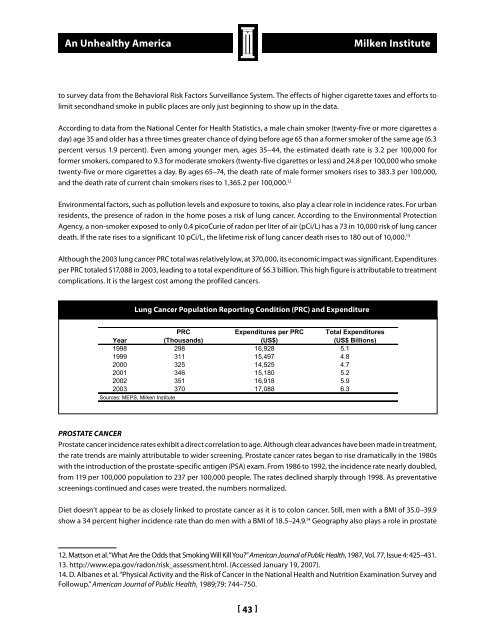An Unhealthy America: The Economic Burden of ... - Milken Institute
An Unhealthy America: The Economic Burden of ... - Milken Institute
An Unhealthy America: The Economic Burden of ... - Milken Institute
Create successful ePaper yourself
Turn your PDF publications into a flip-book with our unique Google optimized e-Paper software.
<strong>An</strong> <strong>Unhealthy</strong> <strong>America</strong><strong>Milken</strong> <strong>Institute</strong>to survey data from the Behavioral Risk Factors Surveillance System. <strong>The</strong> effects <strong>of</strong> higher cigarette taxes and efforts tolimit secondhand smoke in public places are only just beginning to show up in the data.According to data from the National Center for Health Statistics, a male chain smoker (twenty-five or more cigarettes aday) age 35 and older has a three times greater chance <strong>of</strong> dying before age 65 than a former smoker <strong>of</strong> the same age (6.3percent versus 1.9 percent). Even among younger men, ages 35–44, the estimated death rate is 3.2 per 100,000 forformer smokers, compared to 9.3 for moderate smokers (twenty-five cigarettes or less) and 24.8 per 100,000 who smoketwenty-five or more cigarettes a day. By ages 65–74, the death rate <strong>of</strong> male former smokers rises to 383.3 per 100,000,and the death rate <strong>of</strong> current chain smokers rises to 1,365.2 per 100,000. 12Environmental factors, such as pollution levels and exposure to toxins, also play a clear role in incidence rates. For urbanresidents, the presence <strong>of</strong> radon in the home poses a risk <strong>of</strong> lung cancer. According to the Environmental ProtectionAgency, a non-smoker exposed to only 0.4 picoCurie <strong>of</strong> radon per liter <strong>of</strong> air (pCi/L) has a 73 in 10,000 risk <strong>of</strong> lung cancerdeath. If the rate rises to a significant 10 pCi/L, the lifetime risk <strong>of</strong> lung cancer death rises to 180 out <strong>of</strong> 10,000. 13Although the 2003 lung cancer PRC total was relatively low, at 370,000, its economic impact was significant. Expendituresper PRC totaled $17,088 in 2003, leading to a total expenditure <strong>of</strong> $6.3 billion. This high figure is attributable to treatmentcomplications. It is the largest cost among the pr<strong>of</strong>iled cancers.Lung Cancer Population Reporting Condition (PRC) and ExpenditureLung Cancer Population Reporting Condition (PRC) and ExpenditurePRC Expenditures Expenditures PRC* per PRC Expenditures/PRCTotal Year Disease(Thousands)(Billions)(US$)(Millions) (Thousands)(US$ Billions)1998 298 16,928 5.1Cancer 48.1 10.6 4.51999 311 15,497 4.82000 Breast Cancer 325 5.5 14,525 1.1 4.7 4.82001 Colon Cancer 346 3.9 15,180 0.3 11.5 5.22002 Lung Cancer 351 6.3 16,918 0.4 17.1 5.92003 Prostate Cancer 370 4.3 17,088 1.0 6.3 4.1Sources: MEPS, <strong>Milken</strong> <strong>Institute</strong>Other Cancers 28.0 7.7 3.6Pulmonary Conditions 45.2 49.2 0.9Diabetes 27.1 13.7 2.0Hypertension 32.5 36.8 0.9PROSTATE CANCERHeart Disease 64.7 19.2 3.4Prostate cancer incidenceStrokerates exhibit a direct correlation13.6to age. Although2.4clear advances have5.6been made in treatment,the rate trends are mainly Mental attributable Disorders to wider screening. 45.8Prostate cancer 30.3 rates began to 1.5 rise dramatically in the 1980swith the introduction Total <strong>of</strong> the prostate-specific antigen 277.0 (PSA) exam. From 162.2 1986 to 1992, the incidence 1.7 rate nearly doubled,from 119 per 100,000 PRC: population Population Reporting to 237 per Condition 100,000 people. <strong>The</strong> rates declined sharply through 1998. As preventativescreenings continued and cases were treated, the numbers normalized.Diet doesn’t appear to be as closely linked to prostate cancer as it is to colon cancer. Still, men with a BMI <strong>of</strong> 35.0–39.9show a 34 percent higher incidence rate than do men with a BMI <strong>of</strong> 18.5–24.9. 14 Geography also plays a role in prostate12. Mattson et al. “What Are the Odds that Smoking Will Kill You?” <strong>America</strong>n Journal <strong>of</strong> Public Health, 1987, Vol. 77, Issue 4: 425–431.13. http://www.epa.gov/radon/risk_assessment.html. (Accessed January 19, 2007).14. D. Albanes et al. “Physical Activity and the Risk <strong>of</strong> Cancer in the National Health and Nutrition Examination Survey andFollowup.” <strong>America</strong>n Journal <strong>of</strong> Public Health, 1989;79: 744–750.[ 43 ]
















